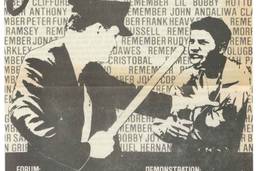What to Do About the Nanny?
Behind the female literati’s neglect of its working-class sisters.
Jude Ellison Sady Doyle

This November, Kate Bolick’s cover story in The Atlantic, “All the Single Ladies,” detailed what she sees as the impending end of heterosexual marriage. The article was blogged, tweeted and discussed to the high heavens – mostly by women, often by women I respect immensely. Plans are afoot to adapt it into a TV series.
Despite the excitement over Bolick’s article, I felt I’d read it before. And I had.
“All the Single Ladies” belongs to a popular type of female journalism: carefully researched, sophisticated, subtly reactionary, each sentence so alluringly polished that you can almost forget it’s a 10,000-word article about how tough it is not to have a boyfriend. I’ve come to think of it as the What To Do About The Nanny genre.
Straight marriage, Bolick argues, is on the way out due to the recession, women’s advances in the workplace, the rise of casual sex and (that eternal culprit) feminism. Given that “men have been rapidly declining – in income, in educational attainment, and in future employment prospects – relative to women,” heterosexual ladies are left in a dating wasteland, forced to choose between “deadbeats or players.” Accordingly, many women remain unmarried – and, Bolick optimistically projects, create communities of their own.
I’m all for sisterhood, but her use of “deadbeats” stuck in my craw. Bolick seems concerned not that straight women will miss out on marriage, but that upper-middle-class women will have to “marry down.” She equates job attainment with desirability. She tells us what “we” could learn from “the African-American community” (implying that “we,” her readers, aren’t part of it). Bolick posits that in vitro fertilization (which costs between $10,000 and $20,000) is always an option for would-be single mothers, as she explains that she “flew around the world to research this article,” staying in a “rambling Cape Cod summer house” and a “handsome mid-century apartment in Chelsea,” while her single female friends traveled through Italy or attended meditation retreats.
The What To Do About The Nanny genre has rules: It will cite the author’s own life as a cautionary example of what feminism hath wrought. It will touch upon the lower orders – community college students, single black mothers, the nanny – and explain how they’re relevant to the upper-middle-class. It will be about “gender,” but focus on the ladies’-magazine variety of female concerns: motherhood, marriage, dating. And it will shame upper-middle-class women for their ambition – and simultaneously imply that they, the women who can afford nannies and have seen the inside of rambling Cape Cod beach houses, are the only people literate enough to care about women’s progress.
Another Atlantic cover story, Caitlin Flanagan’s 2004 “How Serfdom Saved the Women’s Movement,” literally addressed what to do about the nanny. Flanagan feigned concern for poor domestic workers before landing on her point: Nannies are the acceptable variety of child care (she employed one), but were only necessary because modern women were selfish, careerist shrews who wouldn’t stay home with their kids.
Maureen Dowd, in The New York Times, pioneered the fertile Too Rich To Find A Boyfriend sub-genre with 2005’s “What’s a Modern Girl to Do?” After a man told her she was too “intimidating” and successful to date, she wailed that “being a maid would have enhanced my chances with men.”
Three years later, Lori Gottlieb took that ball and ran with it, with The Atlantic’s “Marry Him!”, about how “successful and ambitious” women – with their silly quest for “education! career! but also true love!” – had developed dating expectations that would leave them lonely spinsters. (Gottlieb has also published a more recent Atlantic piece about how middle-class mothers are wrecking their children with – surprise! – overly high expectations.) Even the website Jezebel joined in, republishing an article by the anonymous writer “Legal Tease” about how men are so “intimidated” by law degrees that some will reject a “six-figure-siren who has a white shoe pedigree” in favor of an “unemployed hook-up buddy in Astoria.”
Bolick herself cites Hanna Rosin’s Atlantic piece “The End of Men,” in which Rosin conflates the idea of a “man-cession,” some anecdotes about men struggling in college and (for some reason) Lady Gaga’s “Telephone” video, to conclude that male privilege has ended. This article spends time with working-class men. It talks about community colleges. Its gender-baiting seems refreshingly lacking in class bias. But if you thought it wouldn’t come back to upwardly mobile women and their marriage prospects, think again: Rosin quotes a female student, who tells her, “In 2012, I will be Dr. Burress. Will I have to deal with guys who don’t even have a bachelor’s degree? I would like to date, but I’m putting myself in a really small pool.”
No one wants to hear that they’re going to die alone, endanger their children or end an entire gender just because they work too hard. But the harm of this genre isn’t how it exploits well-off women’s insecurities. It’s how it dismisses the rest of the female population.
Consider the Jezebel piece about the plague of Astorian girlfriends. The target is neither “intimidated” men, nor “successful” women. It’s Legal Tease’s imagined rival: This “28-year-old receptionist” living in “some outer borough” with roommates; this “crackwhore” without health insurance; this unpedigreed working-class woman who has the nerve to date the men Tease wants. This woman is also the maid Maureen Dowd wishes she were, Rosin’s man-ending working-class “matriarch,” the single black mother cited as a cautionary tale by Bolick and the nanny whose plight Flanagan deplores, while insisting that said nanny is every working mother’s must-have accessory.
This woman can’t be shamed into staying home with her kids – she must work so that they can eat. She can’t reject men for not being well-off and still end up in a beach house. In America, 80 percent of women living below the poverty line are unmarried, and this woman’s among them. She’s less worried about Rosin’s idea that “female” management styles are more suited to white-collar jobs than she is about being shuffled into pink-collar “female” jobs that are consistently lower-paying than male-dominated ones.
She is, in other words, the woman feminism is for. “Ambition” isn’t a luxury she can renounce if it interferes with dating; it’s survival. And she’s the woman who is ignored or patronized – if not flat-out blamed – by the What To Do About The Nanny genre.
I don’t believe Bolick intended to attack these women. Her vision of single women forming communities to share emotional support and parenting is lovely. But I wonder: Which women will be left out? Does the sisterhood have a plan for them? And, what are they going to do about the nannies?
Jude Ellison Sady Doyle is an In These Times contributing writer. They are the author of Trainwreck: The Women We Love to Hate, Mock, and Fear… and Why (Melville House, 2016) and was the founder of the blog Tiger Beatdown. You can follow them on Twitter at @sadydoyle.









